Anakena Beach on Easter Island, or Rapa Nui, is more than just a picturesque destination. It’s the sacred landing site of the island’s first Polynesian settlers, a place steeped in cultural significance. Surrounded by the iconic moai statues, this beach offers a window into the rich heritage and resilient spirit of the Rapa Nui people. Exploring Anakena reveals insights into the island’s history and mythology, inviting visitors to unravel the captivating story of this unique civilization. From traditional practices like Haka Pei sled racing to the striking natural beauty, there’s much to discover about the enduring legacy of Rapa Nui.
Key Points
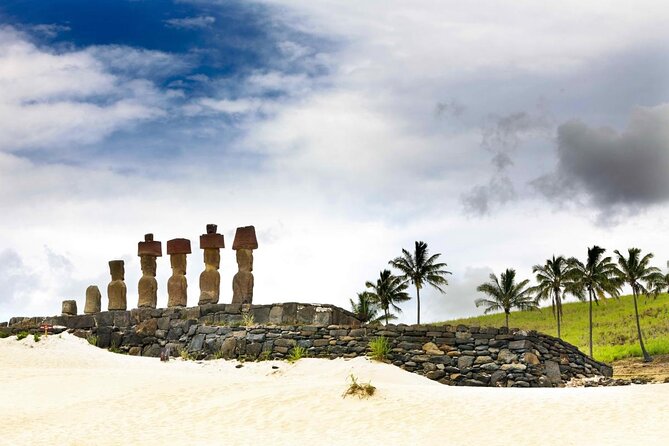
- Anakena Beach is a sacred site believed to be the landing spot for Polynesian settlers on Easter Island, featuring towering moai statues.
- Rano Raraku Crater is the ancient quarry where the iconic moai statues were carved, offering insights into the island’s engineering and artistry.
- Ahu Akahanga Temples served as a center for religious and ceremonial activities, showcasing the ingenuity and spiritual beliefs of the Rapa Nui civilization.
- Rapa Nui culture is a tapestry of unique traditions and legacies, including the Haka Pei sled racing, that have endured despite environmental and cultural challenges.
- Tour guides provide comprehensive understanding of the island’s history, traditions, and environmental challenges, emphasizing the importance of preserving cultural heritage.
Exploring Ahu Akahanga Temples
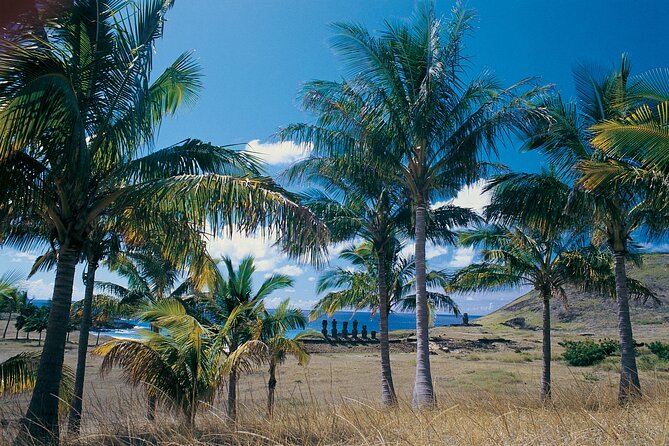
The Ahu Akahanga temples, located on Easter Island, stand as a testament to the island’s rich cultural heritage.
These ancient structures were once the center of religious and ceremonial activities for the Rapa Nui people. Visitors can explore the impressive moai statues that once guarded the site, their weathered faces gazing across the landscape.
The site’s unique layout and the stories behind its construction provide insights into the island’s past.
Exploring Ahu Akahanga offers a glimpse into the ingenuity and spiritual beliefs of the Rapa Nui civilization, leaving visitors with a deeper appreciation for the island’s captivating history.
You can also read our reviews of more tours and experiences in Hanga Roa.
Discovering Rano Raraku Crater
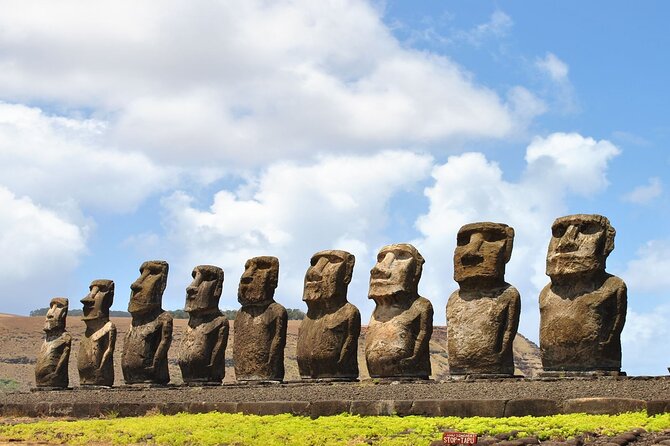
Nestled within the rugged terrain of Easter Island’s volcanic landscape, Rano Raraku crater stands as the enigmatic birthplace of the island’s iconic moai statues.
This ancient quarry was the primary source of the massive volcanic rock used to carve the island’s legendary monumental heads. Visitors can explore the crater’s slopes, where dozens of unfinished moai remain, offering a glimpse into the island’s remarkable engineering and artistry.
The eerie, otherworldly atmosphere of Rano Raraku provides a profound connection to the Rapa Nui culture and the island’s mysterious past.
Exploring this sacred site is a highlight of any Easter Island adventure, allowing travelers to explore the island’s rich history and the enduring legacy of its iconic stone guardians.
Marveling at Anakena Beach
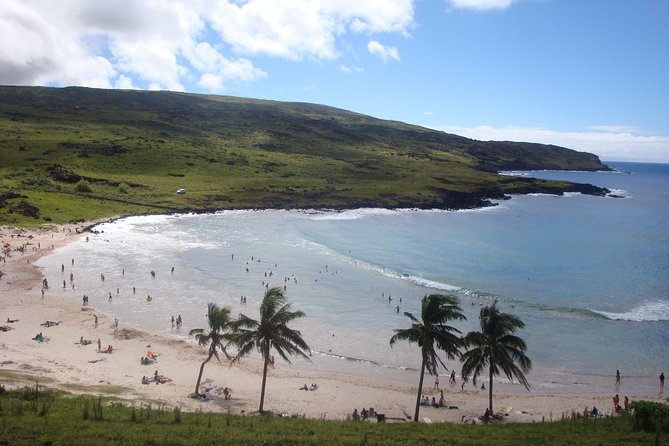
Tucked away on the northern coast of Easter Island, Anakena Beach captivates visitors with its pristine white sands and crystal-clear waters.
This idyllic setting is believed to be the landing site of the island’s first Polynesian settlers, making it a historically significant location.
Travelers stroll along the shore, marveling at the towering moai statues that stand guard nearby.
The beach’s peaceful ambiance and picturesque scenery offer a serene contrast to the island’s more rugged volcanic landscapes.
Anakena’s tranquil atmosphere and connection to Rapa Nui’s ancient past make it a must-visit destination for those exploring the cultural wonders of Easter Island.
Unraveling Rapa Nui History
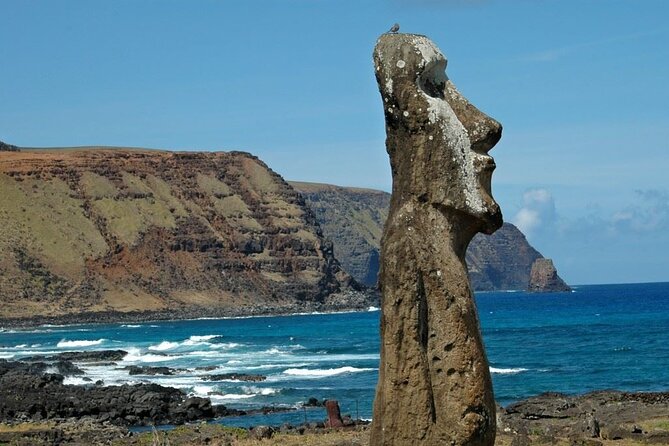
Rapa Nui, also known as Easter Island, boasts a captivating history that has intrigued scholars and travelers alike. This remote, triangular-shaped island located in the South Pacific is home to the enigmatic moai statues, carved by the indigenous Rapa Nui people.
The history of the island reveals:
- Early settlement by Polynesian voyagers around the 12th century AD.
- The rise and fall of the Rapa Nui civilization, marked by deforestation and environmental degradation.
- The island’s encounter with European explorers in the 18th century, leading to cultural disruption and population decline.
- The island’s designation as a UNESCO World Heritage Site in 1995, recognizing its cultural and natural significance.
Unraveling the complex past of Rapa Nui provides insight into the resilience and creativity of its indigenous inhabitants.
Uncovering Rapa Nui Culture
The culture of Easter Island, or Rapa Nui, is a tapestry of intricate traditions and enduring legacies.
Anakena Beach, a breathtaking stretch of white sand, holds deep cultural significance for the Rapa Nui people. It’s believed this idyllic cove was the landing site for the island’s original Polynesian settlers.
Today, Anakena showcases the island’s unique cultural practices, from the towering moai statues to the traditional Haka Pei sled racing.
Visitors can enjoy Rapa Nui’s rich heritage, learning about the island’s history, mythology, and the resilience of its indigenous communities.
Exploring Anakena and the island’s cultural sites offers a profound understanding of the Rapa Nui’s remarkable resilience and the enduring spirit of their traditions.
- Easter Island Full-Day Tour: Ahu Tongariki, Rano Raraku and Anakena Beach
- Private Full-Day Easter Island Highlights North and West
- Small Group Wines and Flavours Guided Walking Tour
- Private Tour: Full-Day Easter Island Archeological Sites
- Private Tour: Tongariki Sunrise Experience
- Full Day Tour in Rapa Nui
Insights From the Tour Guide
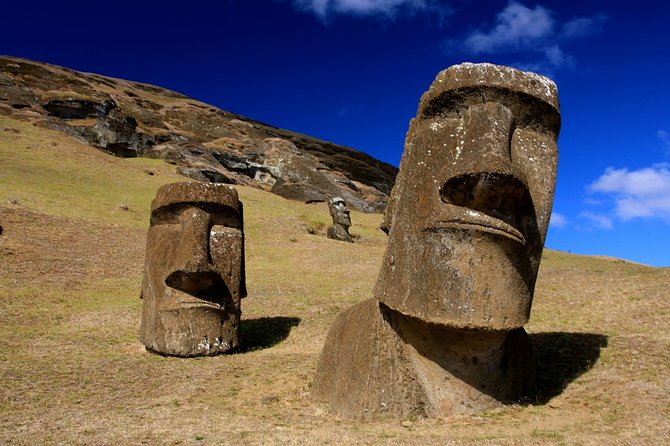
According to the tour guide, a wealth of insights emerged from exploring Anakena Beach and the broader Rapa Nui culture.
The guide highlighted several key points:
-
The significance of Anakena Beach as a sacred site, once the landing place for the island’s first inhabitants.
-
The intricate symbolism and spiritual meaning behind the iconic moai statues.
-
The island’s precarious environmental balance, with the guide emphasizing the need for sustainable tourism.
-
The importance of preserving Rapa Nui’s rich cultural heritage and engaging with the local community.
The tour provided a comprehensive understanding of the island’s history, traditions, and the ongoing challenges faced by this unique UNESCO World Heritage Site.
Considerations for Visitors
For visitors to Anakena Beach and Rapa Nui, several key considerations come into play.
The full-day tour exploring this UNESCO World Heritage Site provides access to iconic locations like the Ahu Akahanga temples and Rano Raraku crater. While the small group size allows for personalized attention, the tour doesn’t include lunch or personal expenses.
Timing is crucial, as the tour starts at 9 AM and may encounter logistical hassles. Pricing can also be a factor, as the $156.88 per person cost varies based on group size.
Feedback and Reflections
Feedback on the Anakena and Rapa Nui culture tour has been mixed, with both positive and negative experiences reported by customers.
The tour highlights, such as the UNESCO World Heritage site and the guide’s knowledge, have received praise.
However, concerns have been raised about pricing, service issues, and logistical challenges:
- Pricing complaints, with customers feeling the tour was overpriced.
- Dissatisfaction with lack of inclusions, like lunch, and difficulties with refunds.
- Transportation and pickup problems, including inconvenient meeting points.
- Acknowledgment by the company of customer frustrations and a commitment to improve service based on feedback.
Frequently Asked Questions
What Is the Average Group Size for This Tour?
The tour has a small group size, with a maximum of 15 travelers. This allows for personalized attention from the guide and a more intimate experience exploring the sites of Easter Island.
Are There Any Age Restrictions for This Tour?
The tour doesn’t have any age restrictions. It’s suitable for travelers of all ages. The small group size of 15 or fewer allows the guide to provide personalized attention to each participant.
Can I Purchase Additional Services During the Tour?
Yes, travelers can purchase additional services during the tour, such as lunch or gratuities. However, these personal expenses are not included in the tour price and must be paid separately by the customer.
Is There a Discount for Booking the Tour in Advance?
The tour company doesn’t offer discounts for booking in advance. Prices are fixed and vary only by group size. Customers should book early to secure their preferred travel dates, as availability may be limited.
What Is the Cancellation and Refund Policy for This Tour?
The cancellation and refund policy for this tour is unclear from the provided information. The company has acknowledged customer concerns about difficulties with refunds, but specifics are not provided. It’s recommended to check with the tour operator directly for their full policy details.
Recap
Visiting Anakena Beach and the surrounding sites on Easter Island offers a profound connection to the Rapa Nui culture. Exploring the island’s rich heritage, from the towering moai statues to the vibrant traditions, provides invaluable insights into the resilience and enduring spirit of this remarkable civilization. Tourists can enjoy the island’s captivating history and mythology, leaving with a deeper understanding and appreciation for the Rapa Nui people’s legacy.
More Tour Reviews in Hanga Roa
Not for you? Here's more things to do in Hanga Roa we have recnetly reviewed
- 2 Best Guided Tours In Hanga Roa
- 6 Best 2 Day Tours In Hanga Roa
- 6 Best Full-Day Tours In Hanga Roa
- 2 Best Private Car With Driver Services In Hanga Roa
- 8 Best Cruises And Boat Tours In Hanga Roa
- The Birdman Journey in Easter Island
- Rapa Nui Dinner Show on Easter Island
- Dinner, Show and Traditional Curanto Te Raai Cultural Experience
- Volcanic Wonders and the Kingdom of the Birdman: Half Day
- Private Tour: Easter Island Caves
- 4-Days Trip to Discover Easter Island
- Anakena and Rapa Nui Culture in Easter Island
